Asphalt Market Size 2025-2029
The asphalt market size is valued to increase by USD 17.38 billion, at a CAGR of 5.1% from 2024 to 2029. Infrastructure development and road construction will drive the asphalt market.
Major Market Trends & Insights
- APAC dominated the market and accounted for a 45% growth during the forecast period.
- By Product Type - Hot mix asphalt segment was valued at USD 36.06 billion in 2024
- By End-user - Non-residential construction segment accounted for the largest market revenue share in 2024
Market Size & Forecast
- Market Opportunities: USD 48.55 million
- Market Future Opportunities: USD 17378.00 million
- CAGR from 2024 to 2029 : 5.1%
Market Summary
- The market plays a pivotal role in the infrastructure development sector, particularly in road construction and maintenance. This market is driven by various factors, including the increasing demand for sustainable production methods and the need to address the volatility in crude oil prices. Sustainable production is a key trend in the asphalt industry, with manufacturers focusing on reducing carbon emissions and improving energy efficiency. For instance, some companies are exploring the use of recycled asphalt pavement and warm-mix asphalt technologies to minimize the environmental impact of production. One real-world business scenario where the market comes into play is supply chain optimization.
- A construction company, for instance, may need to ensure a steady supply of asphalt to meet project deadlines while also minimizing costs. By implementing an effective supply chain strategy, the company can negotiate favorable prices with suppliers, optimize transportation routes, and maintain an adequate inventory level to avoid production delays. According to recent studies, implementing such strategies can lead to significant improvements in operational efficiency. For example, a construction firm was able to reduce its lead time for asphalt deliveries by 20%, resulting in a 15% increase in project completion rate and a 10% reduction in overall project costs.
- By focusing on supply chain optimization, the company was able to maintain a competitive edge in the market while also ensuring compliance with environmental regulations.
What will be the Size of the Asphalt Market during the forecast period?
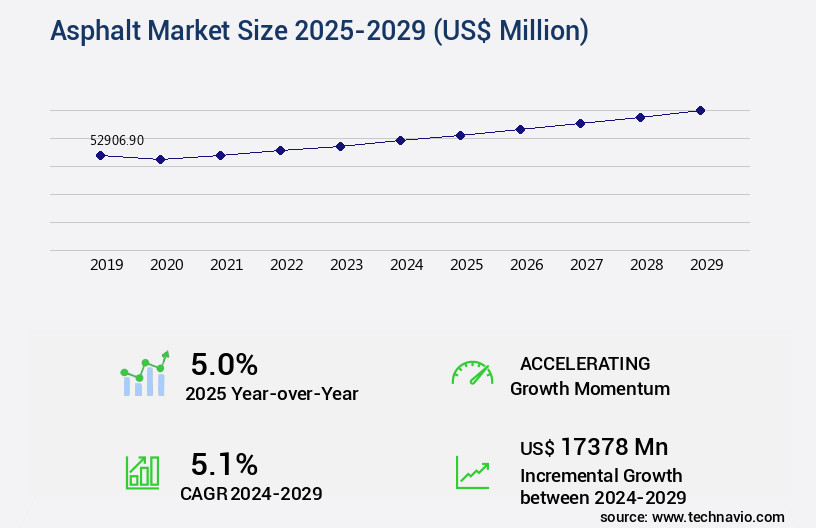
Get Key Insights on Market Forecast (PDF) Request Free Sample
How is the Asphalt Market Segmented ?
The asphalt industry research report provides comprehensive data (region-wise segment analysis), with forecasts and estimates in "USD million" for the period 2025-2029, as well as historical data from 2020-2023 for the following segments.
- Product Type
- Hot mix asphalt
- Warm mix asphalt
- Cold mix asphalt
- Others
- End-user
- Non-residential construction
- Residential construction
- Others
- Application
- Paving
- Roofing
- Waterproofing
- Geography
- North America
- Europe
- APAC
- China
- India
- Indonesia
- Japan
- South America
- Rest of World (ROW)
By Product Type Insights
The hot mix asphalt segment is estimated to witness significant growth during the forecast period.
The market encompasses the production and application of hot mix asphalt (HMA), a crucial infrastructure material for paving roads, highways, and parking lots. HMA, composed of asphalt cement, mineral aggregate, and water, is renowned for its rapid hardening properties and superior traction under elevated temperatures. The market's continuous evolution is marked by advancements in HMA design and production methods, including marshall mix design, thermal cracking evaluation, and pothole repair techniques. Superior quality control procedures ensure the consistency of asphalt concrete mixtures, with indirect tensile strength and polymer modified asphalt enhancing durability. Asphalt recycling processes, such as reclaimed asphalt pavement (RAP) usage, promote sustainability and cost savings.
Performance-based specifications, like gyratory compaction testing and rutting resistance testing, ensure optimal pavement design parameters. Key performance indicators, like fatigue cracking prediction and life cycle assessment, guide sustainable pavement materials selection. Aggregate gradation control, crack sealing techniques, and environmental impact assessment are integral to the market's ongoing development. Asphalt binder properties, such as asphalt emulsion types and flexural creep testing, are crucial for enhancing asphalt's structural design standards. Incorporating advanced technologies, the market embraces pavement performance modeling, air voids measurement, and asphalt rejuvenation methods to maintain and improve pavement quality. With a global market size projected to reach USD120 billion by 2027, the market remains a dynamic and essential sector in infrastructure development.
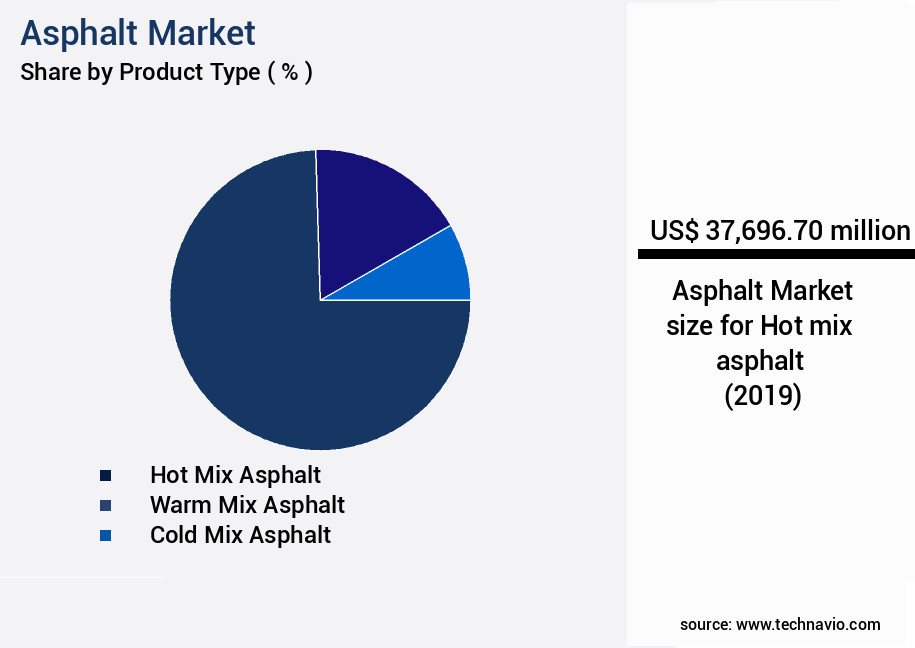
Request Free Sample
The Hot mix asphalt segment was valued at USD 36.06 billion in 2020 and showed a gradual increase during the forecast period.
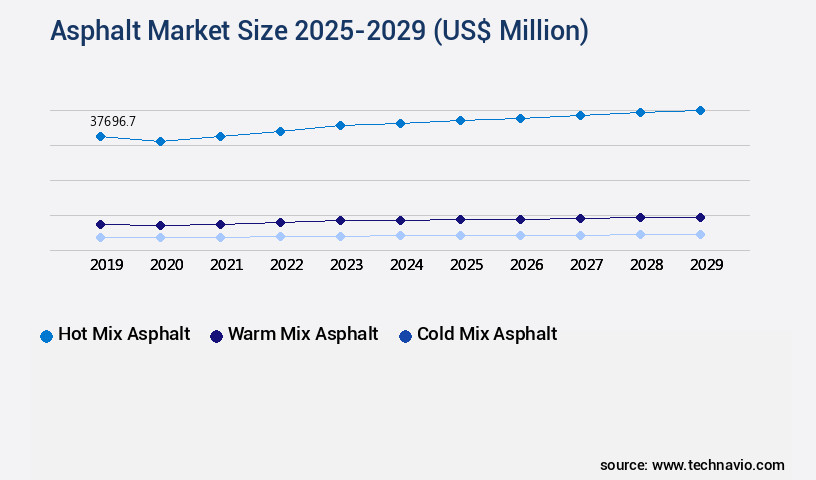
Request Free Sample
Regional Analysis
APAC is estimated to contribute 45% to the growth of the global market during the forecast period.Technavio's analysts have elaborately explained the regional trends and drivers that shape the market during the forecast period.
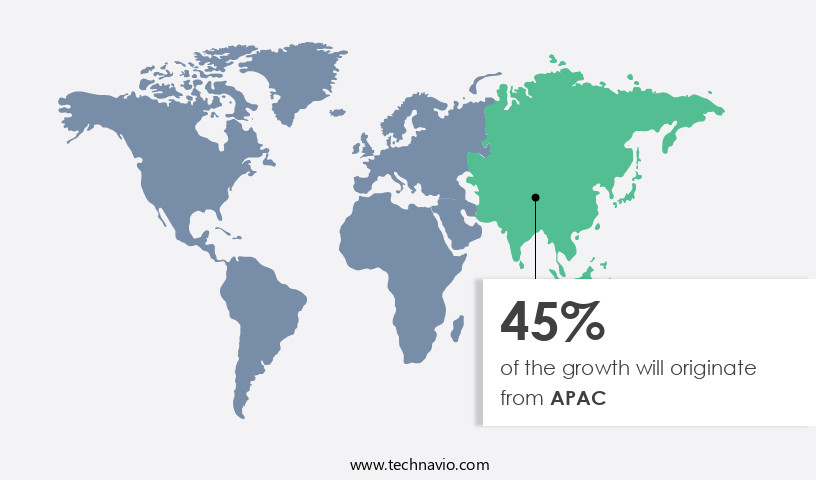
See How Asphalt Market Demand is Rising in APAC Request Free Sample
The Asia-Pacific (APAC) the market is witnessing significant growth due to substantial infrastructure investments, urbanization, and technological advancements in road construction. This region is home to several emerging and mature economies, with China leading the charge. In 2024, the Chinese construction industry generated an impressive USD1.24 trillion in value added, marking a 3.8% increase from the previous year. This growth is fueled by a high urbanization rate of approximately 65%, driving the demand for new roads, expressways, and urban infrastructure.
Asphalt and bitumen-based solutions are the preferred choice for these projects due to their cost-effectiveness and operational efficiency. In fact, the use of asphalt pavement results in a 20% reduction in construction time compared to concrete pavement. The APAC the market's growth trajectory is further propelled by advancements in asphalt technology, such as warm-mix asphalt and recycled asphalt pavement, which offer cost savings and environmental benefits.
Market Dynamics
Our researchers analyzed the data with 2024 as the base year, along with the key drivers, trends, and challenges. A holistic analysis of drivers will help companies refine their marketing strategies to gain a competitive advantage.
The market is experiencing significant growth due to the increasing demand for optimizing asphalt binder viscosity and designing resilient asphalt pavements. Advanced asphalt testing methodologies play a crucial role in predicting pavement fatigue cracking and evaluating asphalt pavement performance. Aggregate shape and texture analysis are essential in improving asphalt mix durability and assessing the quality of asphalt aggregates. Environmental factors significantly impact asphalt performance, making it necessary to implement sustainable pavement practices. This includes reducing asphalt pavement maintenance and assessing the environmental impact of asphalt. New asphalt pavement technologies, such as innovative asphalt pavement construction and using reclaimed asphalt pavement (RAP) in mixes, are gaining popularity for their ability to improve long-term performance and reduce the carbon footprint. Measuring asphalt binder stiffness is critical in ensuring the relationship between asphalt mix design and performance. The effect of temperature on asphalt performance is also a significant consideration, and designers must account for it in their mix designs. Predicting pavement fatigue cracking and determining the optimum asphalt content in mixes are key challenges that require continuous research and development. In conclusion, the market is evolving, with a focus on optimizing asphalt performance through advanced testing methodologies, sustainable practices, and new technologies. By addressing the impact of environmental factors and improving asphalt mix durability, stakeholders can reduce maintenance costs and ensure the long-term sustainability of asphalt pavements.
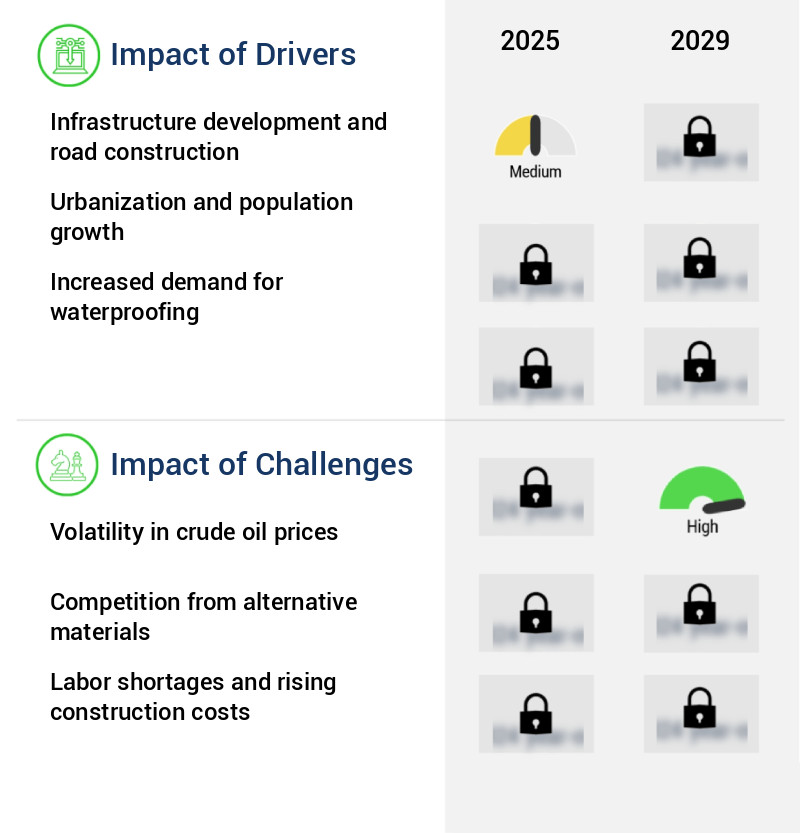
What are the key market drivers leading to the rise in the adoption of Asphalt Industry?
- Infrastructure development, specifically road construction, serves as the primary catalyst for market growth.
- Asphalt continues to be a crucial component in infrastructure development, particularly in road construction and maintenance. Global markets witness a significant demand for asphalt due to its durability, cost-effectiveness, and versatility. Governments worldwide invest heavily in capital-intensive infrastructure projects to stimulate economic growth and improve connectivity. For instance, India's Union Budget 2024-25 allocated ₹1 trillion (USD133.5 billion) for capital expenditure, a 3.4% share of the national Gross Domestic Product. This investment emphasizes the commitment to expanding and upgrading transportation networks, including national highways, rural roads, and urban transit corridors.
- Programs like Bharatmala and PM Gati Shakti are expected to sustain high asphalt consumption due to their focus on road connectivity. The market's growth is driven by these infrastructure initiatives, leading to increased efficiency, reduced downtime, and improved decision-making for businesses involved in infrastructure development.
What are the market trends shaping the Asphalt Industry?
- Focusing on sustainable production is an emerging market trend. It is essential for businesses to prioritize environmentally friendly practices in their production processes.
- The market is undergoing significant transformation, with a growing emphasis on sustainable production and applications across various sectors. Manufacturers are investing in innovative technologies and infrastructure to minimize carbon emissions, conserve energy, and promote circularity in material use. For instance, Tarmac, a leading company, introduced a sustainable asphalt plant in Trowse, Norwich, England, in June 2024. This facility incorporates underfloor heating systems, on-site wind turbines, and rail-delivered aggregates to reduce emissions throughout production.
- The plant produces eco-friendly asphalt products like UltiLayer and UltiPorous, which cater to roads, driveways, and infrastructure projects. This shift towards sustainable asphalt solutions contributes to faster project completion, improved forecast accuracy, and cost optimization for clients.
What challenges does the Asphalt Industry face during its growth?
- The volatility in crude oil prices poses a significant challenge to the growth of the industry, requiring professionals to closely monitor and adapt to market fluctuations.
- The market experiences continuous evolution, driven by its primary connection to petroleum refining and the volatile nature of crude oil prices. Asphalt, which utilizes bitumen as its primary binding agent, is an essential component in road construction and maintenance. The sensitivity of asphalt production to oil market fluctuations is evident; rising crude prices result in increased input costs, narrowed profit margins, and potential supply chain disruptions. For instance, the 2022 energy crisis, instigated by geopolitical tensions, caused oil prices to surge past USD120 per barrel.
- Consequently, European bitumen supplies were strained due to sanctions on Russian crude, compelling contractors to seek alternative sources at premium prices. This disruption resulted in significant budget overruns and project delays across various regions. Despite these challenges, the market remains a crucial player in the infrastructure sector, adapting to market fluctuations and ensuring the continued development and maintenance of roads worldwide.
Exclusive Technavio Analysis on Customer Landscape
The asphalt market forecasting report includes the adoption lifecycle of the market, covering from the innovator's stage to the laggard's stage. It focuses on adoption rates in different regions based on penetration. Furthermore, the asphalt market report also includes key purchase criteria and drivers of price sensitivity to help companies evaluate and develop their market growth analysis strategies.
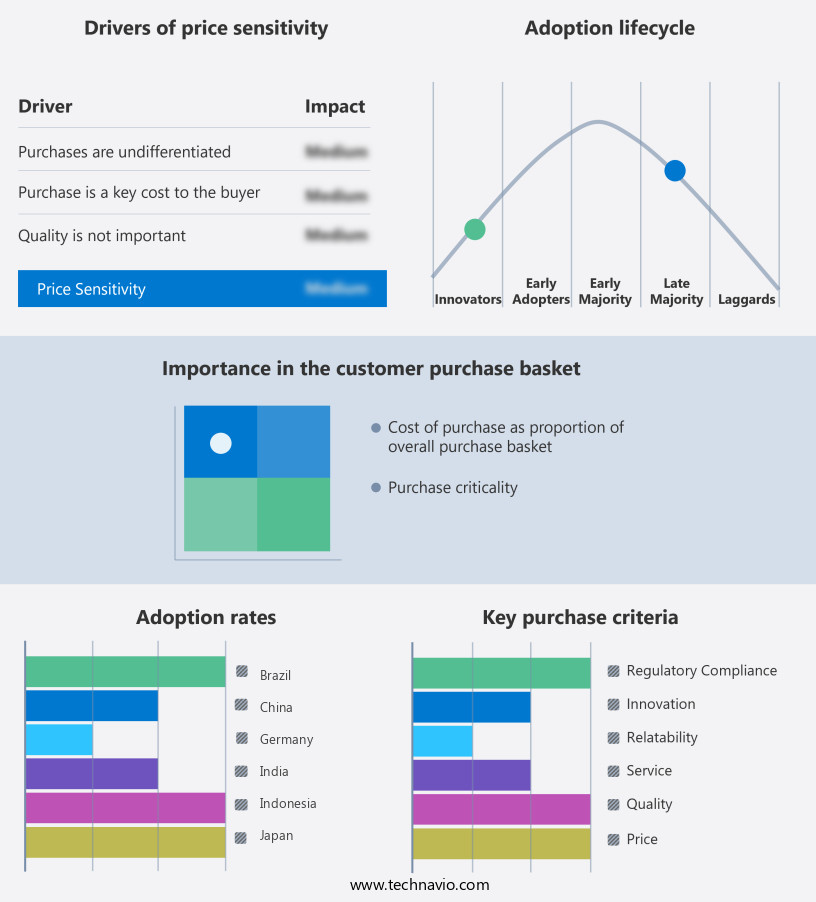
Customer Landscape of Asphalt Industry
Competitive Landscape
Companies are implementing various strategies, such as strategic alliances, asphalt market forecast, partnerships, mergers and acquisitions, geographical expansion, and product/service launches, to enhance their presence in the industry.
Aggregate Industries UK Ltd. - Asphalt is a key material in road construction, utilized extensively for highway and motorway projects worldwide. This petroleum product's durability and flexibility make it an indispensable component in infrastructure development. The company specializes in its production and distribution, contributing significantly to the global market.
The industry research and growth report includes detailed analyses of the competitive landscape of the market and information about key companies, including:
- Aggregate Industries UK Ltd.
- Boral Ltd.
- BP Plc
- CEMEX SAB de CV
- Chevron Corp.
- CRH Plc
- Exxon Mobil Corp.
- HeidelbergCement AG
- Marathon Petroleum Corp.
- Owens Corning
- Repsol SA
- Shell plc
- Sinopec Shanghai Petrochemical Co. Ltd.
- TotalEnergies SE
- United Refining Co.
- Valero Energy Corp.
- Vulcan Materials Co.
Qualitative and quantitative analysis of companies has been conducted to help clients understand the wider business environment as well as the strengths and weaknesses of key industry players. Data is qualitatively analyzed to categorize companies as pure play, category-focused, industry-focused, and diversified; it is quantitatively analyzed to categorize companies as dominant, leading, strong, tentative, and weak.
Recent Development and News in Asphalt Market
- In August 2024, global asphalt producer, Caterpillar Asphalt, announced the launch of its innovative new asphalt plant in Texas, capable of producing 300 tons per hour, marking a significant expansion to its production capacity (Caterpillar Asphalt Press Release, 2024). In November 2024, leading asphalt manufacturers, Bitumen LLC and Nynas, entered into a strategic partnership to jointly develop and market sustainable asphalt binders, aiming to reduce the carbon footprint of road construction (Bitumen LLC & Nynas Press Release, 2024).
- In February 2025, European the market leader, Ineos Styrolution, completed the acquisition of competitor, Covestro's Styrolution business, expanding its market share and product portfolio (Ineos Styrolution Press Release, 2025). In May 2025, the European Union approved the use of recycled asphalt in road construction, a key policy change that is expected to boost the demand for recycled asphalt and reduce the environmental impact of the industry (European Commission Press Release, 2025).
Dive into Technavio's robust research methodology, blending expert interviews, extensive data synthesis, and validated models for unparalleled Asphalt Market insights. See full methodology.
|
Market Scope
|
|
Report Coverage
|
Details
|
|
Page number
|
239
|
|
Base year
|
2024
|
|
Historic period
|
2020-2023 |
|
Forecast period
|
2025-2029
|
|
Growth momentum & CAGR
|
Accelerate at a CAGR of 5.1%
|
|
Market growth 2025-2029
|
USD 17378 million
|
|
Market structure
|
Fragmented
|
|
YoY growth 2024-2025(%)
|
5.0
|
|
Key countries
|
China, US, India, Japan, Indonesia, Russia, Germany, Brazil, Mexico, and Saudi Arabia
|
|
Competitive landscape
|
Leading Companies, Market Positioning of Companies, Competitive Strategies, and Industry Risks
|
Request Free Sample
Research Analyst Overview
- The market continues to evolve, driven by advancements in technology and shifting industry trends. Quality control procedures play a crucial role in ensuring the consistency and durability of asphalt concrete mixtures. Marshall mix design and thermal cracking evaluation are essential elements of the design process, optimizing the performance of hot mix asphalt. Pothole repair methods have evolved, with an increasing focus on sustainability. For instance, recycling processes, such as reclaimed asphalt pavement (RAP) and asphalt recycling, have gained popularity due to their environmental benefits. In fact, industry growth is expected to reach 3% annually, with a significant emphasis on performance-based specifications and sustainable pavement materials.
- Polymer modified asphalt, for example, offers improved indirect tensile strength and rutting resistance, making it a preferred choice for pavement design parameters. Gyratory compaction testing, rutting resistance testing, and dynamic modulus testing are essential in evaluating the performance of asphalt binder properties and ensuring compliance with structural design standards. Crack sealing techniques, such as asphalt emulsion types, have become essential in preventing pavement distress identification. Flexural creep testing and pavement preservation strategies, like asphalt rejuvenation methods, extend pavement life and reduce the need for costly repairs. Environmental impact assessment is also a critical consideration, with ongoing research into the use of aggregate gradation control and superpave mix design to minimize the carbon footprint of asphalt production.
- Air voids measurement and void content determination are essential in assessing the long-term performance of asphalt pavements. Traffic loading analysis and fatigue cracking prediction are crucial in understanding the impact of traffic on pavement structures and implementing effective maintenance strategies. Overall, the market remains a dynamic and innovative industry, continually adapting to meet the evolving needs of transportation infrastructure.
What are the Key Data Covered in this Asphalt Market Research and Growth Report?
-
What is the expected growth of the Asphalt Market between 2025 and 2029?
-
What segmentation does the market report cover?
-
The report is segmented by Product Type (Hot mix asphalt, Warm mix asphalt, Cold mix asphalt, and Others), End-user (Non-residential construction, Residential construction, and Others), Application (Paving, Roofing, and Waterproofing), and Geography (APAC, North America, Europe, Middle East and Africa, and South America)
-
Which regions are analyzed in the report?
-
APAC, North America, Europe, Middle East and Africa, and South America
-
What are the key growth drivers and market challenges?
-
Who are the major players in the Asphalt Market?
-
Aggregate Industries UK Ltd., Boral Ltd., BP Plc, CEMEX SAB de CV, Chevron Corp., CRH Plc, Exxon Mobil Corp., HeidelbergCement AG, Marathon Petroleum Corp., Owens Corning, Repsol SA, Shell plc, Sinopec Shanghai Petrochemical Co. Ltd., TotalEnergies SE, United Refining Co., Valero Energy Corp., and Vulcan Materials Co.
Market Research Insights
- The market is a dynamic and ever-evolving industry, encompassing various aspects such as material properties, rut depth measurement, and asphalt oxidation resistance. For instance, the latest advancements in asphalt technology have led to the development of binders with enhanced oxidation resistance, extending pavement life and reducing maintenance costs. Moreover, the industry is anticipated to witness significant growth, with estimates suggesting a steady expansion of approximately 3-5% annually. An illustrative example of market trends can be observed in the implementation of advanced construction techniques that improve long-term performance and reduce emission levels. For instance, the adoption of warm-mix asphalt technology has led to a decrease in fuel consumption and greenhouse gas emissions by up to 30% compared to traditional hot-mix asphalt.
- This not only contributes to environmental sustainability but also enhances the overall efficiency of the construction process. Furthermore, the importance of material characterization tests, such as those measuring crack density mapping and fatigue life prediction, has become increasingly critical in ensuring the durability and cost-effectiveness of asphalt pavements. By implementing performance-based specifications and pavement management systems, agencies can optimize their mix designs and allocate resources more effectively, ultimately leading to improved pavement quality and extended service life.
We can help! Our analysts can customize this asphalt market research report to meet your requirements.
Get in touch
1 Executive Summary
- 1.1 Market overview
- Executive Summary - Chart on Market Overview
- Executive Summary - Data Table on Market Overview
- Executive Summary - Chart on Global Market Characteristics
- Executive Summary - Chart on Market by Geography
- Executive Summary - Chart on Market Segmentation by Product Type
- Executive Summary - Chart on Market Segmentation by End-user
- Executive Summary - Chart on Market Segmentation by Application
- Executive Summary - Chart on Incremental Growth
- Executive Summary - Data Table on Incremental Growth
- Executive Summary - Chart on Company Market Positioning
2 Technavio Analysis
- 2.1 Analysis of price sensitivity, lifecycle, customer purchase basket, adoption rates, and purchase criteria
- Analysis of price sensitivity, lifecycle, customer purchase basket, adoption rates, and purchase criteria
- 2.2 Criticality of inputs and Factors of differentiation
- Overview on criticality of inputs and factors of differentiation
- 2.3 Factors of disruption
- Overview on factors of disruption
- 2.4 Impact of drivers and challenges
- Impact of drivers and challenges in 2024 and 2029
3 Market Landscape
- 3.1 Market ecosystem
- Parent Market
- Data Table on - Parent Market
- 3.2 Market characteristics
- Market characteristics analysis
4 Market Sizing
- 4.1 Market definition
- Offerings of companies included in the market definition
- 4.2 Market segment analysis
- 4.4 Market outlook: Forecast for 2024-2029
- Chart on Global - Market size and forecast 2024-2029 ($ million)
- Data Table on Global - Market size and forecast 2024-2029 ($ million)
- Chart on Global Market: Year-over-year growth 2024-2029 (%)
- Data Table on Global Market: Year-over-year growth 2024-2029 (%)
5 Historic Market Size
- 5.1 Global Asphalt Market 2019 - 2023
- Historic Market Size - Data Table on Global Asphalt Market 2019 - 2023 ($ million)
- 5.2 Product Type segment analysis 2019 - 2023
- Historic Market Size - Product Type Segment 2019 - 2023 ($ million)
- 5.3 End-user segment analysis 2019 - 2023
- Historic Market Size - End-user Segment 2019 - 2023 ($ million)
- 5.4 Application segment analysis 2019 - 2023
- Historic Market Size - Application Segment 2019 - 2023 ($ million)
- 5.5 Geography segment analysis 2019 - 2023
- Historic Market Size - Geography Segment 2019 - 2023 ($ million)
- 5.6 Country segment analysis 2019 - 2023
- Historic Market Size - Country Segment 2019 - 2023 ($ million)
6 Qualitative Analysis
- 6.1 Impact Analysis of U.S. Tariffs on Global Asphalt Market
7 Five Forces Analysis
- 7.1 Five forces summary
- Five forces analysis - Comparison between 2024 and 2029
- 7.2 Bargaining power of buyers
- Bargaining power of buyers - Impact of key factors 2024 and 2029
- 7.3 Bargaining power of suppliers
- Bargaining power of suppliers - Impact of key factors in 2024 and 2029
- 7.4 Threat of new entrants
- Threat of new entrants - Impact of key factors in 2024 and 2029
- 7.5 Threat of substitutes
- Threat of substitutes - Impact of key factors in 2024 and 2029
- 7.6 Threat of rivalry
- Threat of rivalry - Impact of key factors in 2024 and 2029
- 7.7 Market condition
- Chart on Market condition - Five forces 2024 and 2029
8 Market Segmentation by Product Type
- 8.1 Market segments
- Chart on Product Type - Market share 2024-2029 (%)
- Data Table on Product Type - Market share 2024-2029 (%)
- 8.2 Comparison by Product Type
- Chart on Comparison by Product Type
- Data Table on Comparison by Product Type
- 8.3 Hot mix asphalt - Market size and forecast 2024-2029
- Chart on Hot mix asphalt - Market size and forecast 2024-2029 ($ million)
- Data Table on Hot mix asphalt - Market size and forecast 2024-2029 ($ million)
- Chart on Hot mix asphalt - Year-over-year growth 2024-2029 (%)
- Data Table on Hot mix asphalt - Year-over-year growth 2024-2029 (%)
- 8.4 Warm mix asphalt - Market size and forecast 2024-2029
- Chart on Warm mix asphalt - Market size and forecast 2024-2029 ($ million)
- Data Table on Warm mix asphalt - Market size and forecast 2024-2029 ($ million)
- Chart on Warm mix asphalt - Year-over-year growth 2024-2029 (%)
- Data Table on Warm mix asphalt - Year-over-year growth 2024-2029 (%)
- 8.5 Cold mix asphalt - Market size and forecast 2024-2029
- Chart on Cold mix asphalt - Market size and forecast 2024-2029 ($ million)
- Data Table on Cold mix asphalt - Market size and forecast 2024-2029 ($ million)
- Chart on Cold mix asphalt - Year-over-year growth 2024-2029 (%)
- Data Table on Cold mix asphalt - Year-over-year growth 2024-2029 (%)
- 8.6 Others - Market size and forecast 2024-2029
- Chart on Others - Market size and forecast 2024-2029 ($ million)
- Data Table on Others - Market size and forecast 2024-2029 ($ million)
- Chart on Others - Year-over-year growth 2024-2029 (%)
- Data Table on Others - Year-over-year growth 2024-2029 (%)
- 8.7 Market opportunity by Product Type
- Market opportunity by Product Type ($ million)
- Data Table on Market opportunity by Product Type ($ million)
9 Market Segmentation by End-user
- 9.1 Market segments
- Chart on End-user - Market share 2024-2029 (%)
- Data Table on End-user - Market share 2024-2029 (%)
- 9.2 Comparison by End-user
- Chart on Comparison by End-user
- Data Table on Comparison by End-user
- 9.3 Non-residential construction - Market size and forecast 2024-2029
- Chart on Non-residential construction - Market size and forecast 2024-2029 ($ million)
- Data Table on Non-residential construction - Market size and forecast 2024-2029 ($ million)
- Chart on Non-residential construction - Year-over-year growth 2024-2029 (%)
- Data Table on Non-residential construction - Year-over-year growth 2024-2029 (%)
- 9.4 Residential construction - Market size and forecast 2024-2029
- Chart on Residential construction - Market size and forecast 2024-2029 ($ million)
- Data Table on Residential construction - Market size and forecast 2024-2029 ($ million)
- Chart on Residential construction - Year-over-year growth 2024-2029 (%)
- Data Table on Residential construction - Year-over-year growth 2024-2029 (%)
- 9.5 Others - Market size and forecast 2024-2029
- Chart on Others - Market size and forecast 2024-2029 ($ million)
- Data Table on Others - Market size and forecast 2024-2029 ($ million)
- Chart on Others - Year-over-year growth 2024-2029 (%)
- Data Table on Others - Year-over-year growth 2024-2029 (%)
- 9.6 Market opportunity by End-user
- Market opportunity by End-user ($ million)
- Data Table on Market opportunity by End-user ($ million)
10 Market Segmentation by Application
- 10.1 Market segments
- Chart on Application - Market share 2024-2029 (%)
- Data Table on Application - Market share 2024-2029 (%)
- 10.2 Comparison by Application
- Chart on Comparison by Application
- Data Table on Comparison by Application
- 10.3 Paving - Market size and forecast 2024-2029
- Chart on Paving - Market size and forecast 2024-2029 ($ million)
- Data Table on Paving - Market size and forecast 2024-2029 ($ million)
- Chart on Paving - Year-over-year growth 2024-2029 (%)
- Data Table on Paving - Year-over-year growth 2024-2029 (%)
- 10.4 Roofing - Market size and forecast 2024-2029
- Chart on Roofing - Market size and forecast 2024-2029 ($ million)
- Data Table on Roofing - Market size and forecast 2024-2029 ($ million)
- Chart on Roofing - Year-over-year growth 2024-2029 (%)
- Data Table on Roofing - Year-over-year growth 2024-2029 (%)
- 10.5 Waterproofing - Market size and forecast 2024-2029
- Chart on Waterproofing - Market size and forecast 2024-2029 ($ million)
- Data Table on Waterproofing - Market size and forecast 2024-2029 ($ million)
- Chart on Waterproofing - Year-over-year growth 2024-2029 (%)
- Data Table on Waterproofing - Year-over-year growth 2024-2029 (%)
- 10.6 Market opportunity by Application
- Market opportunity by Application ($ million)
- Data Table on Market opportunity by Application ($ million)
11 Customer Landscape
- 11.1 Customer landscape overview
- Analysis of price sensitivity, lifecycle, customer purchase basket, adoption rates, and purchase criteria
12 Geographic Landscape
- 12.1 Geographic segmentation
- Chart on Market share by geography 2024-2029 (%)
- Data Table on Market share by geography 2024-2029 (%)
- 12.2 Geographic comparison
- Chart on Geographic comparison
- Data Table on Geographic comparison
- 12.3 APAC - Market size and forecast 2024-2029
- Chart on APAC - Market size and forecast 2024-2029 ($ million)
- Data Table on APAC - Market size and forecast 2024-2029 ($ million)
- Chart on APAC - Year-over-year growth 2024-2029 (%)
- Data Table on APAC - Year-over-year growth 2024-2029 (%)
- 12.4 North America - Market size and forecast 2024-2029
- Chart on North America - Market size and forecast 2024-2029 ($ million)
- Data Table on North America - Market size and forecast 2024-2029 ($ million)
- Chart on North America - Year-over-year growth 2024-2029 (%)
- Data Table on North America - Year-over-year growth 2024-2029 (%)
- 12.5 Europe - Market size and forecast 2024-2029
- Chart on Europe - Market size and forecast 2024-2029 ($ million)
- Data Table on Europe - Market size and forecast 2024-2029 ($ million)
- Chart on Europe - Year-over-year growth 2024-2029 (%)
- Data Table on Europe - Year-over-year growth 2024-2029 (%)
- 12.6 Middle East and Africa - Market size and forecast 2024-2029
- Chart on Middle East and Africa - Market size and forecast 2024-2029 ($ million)
- Data Table on Middle East and Africa - Market size and forecast 2024-2029 ($ million)
- Chart on Middle East and Africa - Year-over-year growth 2024-2029 (%)
- Data Table on Middle East and Africa - Year-over-year growth 2024-2029 (%)
- 12.7 South America - Market size and forecast 2024-2029
- Chart on South America - Market size and forecast 2024-2029 ($ million)
- Data Table on South America - Market size and forecast 2024-2029 ($ million)
- Chart on South America - Year-over-year growth 2024-2029 (%)
- Data Table on South America - Year-over-year growth 2024-2029 (%)
- 12.8 China - Market size and forecast 2024-2029
- Chart on China - Market size and forecast 2024-2029 ($ million)
- Data Table on China - Market size and forecast 2024-2029 ($ million)
- Chart on China - Year-over-year growth 2024-2029 (%)
- Data Table on China - Year-over-year growth 2024-2029 (%)
- 12.9 US - Market size and forecast 2024-2029
- Chart on US - Market size and forecast 2024-2029 ($ million)
- Data Table on US - Market size and forecast 2024-2029 ($ million)
- Chart on US - Year-over-year growth 2024-2029 (%)
- Data Table on US - Year-over-year growth 2024-2029 (%)
- 12.10 India - Market size and forecast 2024-2029
- Chart on India - Market size and forecast 2024-2029 ($ million)
- Data Table on India - Market size and forecast 2024-2029 ($ million)
- Chart on India - Year-over-year growth 2024-2029 (%)
- Data Table on India - Year-over-year growth 2024-2029 (%)
- 12.11 Japan - Market size and forecast 2024-2029
- Chart on Japan - Market size and forecast 2024-2029 ($ million)
- Data Table on Japan - Market size and forecast 2024-2029 ($ million)
- Chart on Japan - Year-over-year growth 2024-2029 (%)
- Data Table on Japan - Year-over-year growth 2024-2029 (%)
- 12.12 Indonesia - Market size and forecast 2024-2029
- Chart on Indonesia - Market size and forecast 2024-2029 ($ million)
- Data Table on Indonesia - Market size and forecast 2024-2029 ($ million)
- Chart on Indonesia - Year-over-year growth 2024-2029 (%)
- Data Table on Indonesia - Year-over-year growth 2024-2029 (%)
- 12.13 Germany - Market size and forecast 2024-2029
- Chart on Germany - Market size and forecast 2024-2029 ($ million)
- Data Table on Germany - Market size and forecast 2024-2029 ($ million)
- Chart on Germany - Year-over-year growth 2024-2029 (%)
- Data Table on Germany - Year-over-year growth 2024-2029 (%)
- 12.14 Russia - Market size and forecast 2024-2029
- Chart on Russia - Market size and forecast 2024-2029 ($ million)
- Data Table on Russia - Market size and forecast 2024-2029 ($ million)
- Chart on Russia - Year-over-year growth 2024-2029 (%)
- Data Table on Russia - Year-over-year growth 2024-2029 (%)
- 12.15 Brazil - Market size and forecast 2024-2029
- Chart on Brazil - Market size and forecast 2024-2029 ($ million)
- Data Table on Brazil - Market size and forecast 2024-2029 ($ million)
- Chart on Brazil - Year-over-year growth 2024-2029 (%)
- Data Table on Brazil - Year-over-year growth 2024-2029 (%)
- 12.16 Mexico - Market size and forecast 2024-2029
- Chart on Mexico - Market size and forecast 2024-2029 ($ million)
- Data Table on Mexico - Market size and forecast 2024-2029 ($ million)
- Chart on Mexico - Year-over-year growth 2024-2029 (%)
- Data Table on Mexico - Year-over-year growth 2024-2029 (%)
- 12.17 Saudi Arabia - Market size and forecast 2024-2029
- Chart on Saudi Arabia - Market size and forecast 2024-2029 ($ million)
- Data Table on Saudi Arabia - Market size and forecast 2024-2029 ($ million)
- Chart on Saudi Arabia - Year-over-year growth 2024-2029 (%)
- Data Table on Saudi Arabia - Year-over-year growth 2024-2029 (%)
- 12.18 Market opportunity by geography
- Market opportunity by geography ($ million)
- Data Tables on Market opportunity by geography ($ million)
13 Drivers, Challenges, and Opportunity/Restraints
- 13.3 Impact of drivers and challenges
- Impact of drivers and challenges in 2024 and 2029
- 13.4 Market opportunities/restraints
14 Competitive Landscape
- 14.2 Competitive Landscape
- Overview on criticality of inputs and factors of differentiation
- 14.3 Landscape disruption
- Overview on factors of disruption
- 14.4 Industry risks
- Impact of key risks on business
15 Competitive Analysis
- 15.2 Company ranking index
- 15.3 Market positioning of companies
- Matrix on companies position and classification
- 15.4 Boral Ltd.
- Boral Ltd. - Overview
- Boral Ltd. - Product / Service
- Boral Ltd. - Key offerings
- SWOT
- 15.5 BP Plc
- BP Plc - Overview
- BP Plc - Business segments
- BP Plc - Key news
- BP Plc - Key offerings
- BP Plc - Segment focus
- SWOT
- 15.6 CEMEX SAB de CV
- CEMEX SAB de CV - Overview
- CEMEX SAB de CV - Business segments
- CEMEX SAB de CV - Key news
- CEMEX SAB de CV - Key offerings
- CEMEX SAB de CV - Segment focus
- SWOT
- 15.7 Chevron Corp.
- Chevron Corp. - Overview
- Chevron Corp. - Business segments
- Chevron Corp. - Key news
- Chevron Corp. - Key offerings
- Chevron Corp. - Segment focus
- SWOT
- 15.8 CRH Plc
- CRH Plc - Overview
- CRH Plc - Business segments
- CRH Plc - Key news
- CRH Plc - Key offerings
- CRH Plc - Segment focus
- SWOT
- 15.9 Exxon Mobil Corp.
- Exxon Mobil Corp. - Overview
- Exxon Mobil Corp. - Business segments
- Exxon Mobil Corp. - Key news
- Exxon Mobil Corp. - Key offerings
- Exxon Mobil Corp. - Segment focus
- SWOT
- 15.10 HeidelbergCement AG
- HeidelbergCement AG - Overview
- HeidelbergCement AG - Business segments
- HeidelbergCement AG - Key offerings
- HeidelbergCement AG - Segment focus
- SWOT
- 15.11 Marathon Petroleum Corp.
- Marathon Petroleum Corp. - Overview
- Marathon Petroleum Corp. - Business segments
- Marathon Petroleum Corp. - Key offerings
- Marathon Petroleum Corp. - Segment focus
- SWOT
- 15.12 Owens Corning
- Owens Corning - Overview
- Owens Corning - Business segments
- Owens Corning - Key news
- Owens Corning - Key offerings
- Owens Corning - Segment focus
- SWOT
- 15.13 Repsol SA
- Repsol SA - Overview
- Repsol SA - Business segments
- Repsol SA - Key news
- Repsol SA - Key offerings
- Repsol SA - Segment focus
- SWOT
- 15.14 Shell plc
- Shell plc - Overview
- Shell plc - Business segments
- Shell plc - Key news
- Shell plc - Key offerings
- Shell plc - Segment focus
- SWOT
- 15.15 Sinopec Shanghai Petrochemical Co. Ltd.
- Sinopec Shanghai Petrochemical Co. Ltd. - Overview
- Sinopec Shanghai Petrochemical Co. Ltd. - Business segments
- Sinopec Shanghai Petrochemical Co. Ltd. - Key news
- Sinopec Shanghai Petrochemical Co. Ltd. - Key offerings
- Sinopec Shanghai Petrochemical Co. Ltd. - Segment focus
- SWOT
- 15.16 TotalEnergies SE
- TotalEnergies SE - Overview
- TotalEnergies SE - Business segments
- TotalEnergies SE - Key news
- TotalEnergies SE - Key offerings
- TotalEnergies SE - Segment focus
- SWOT
- 15.17 Valero Energy Corp.
- Valero Energy Corp. - Overview
- Valero Energy Corp. - Business segments
- Valero Energy Corp. - Key offerings
- Valero Energy Corp. - Segment focus
- SWOT
- 15.18 Vulcan Materials Co.
- Vulcan Materials Co. - Overview
- Vulcan Materials Co. - Business segments
- Vulcan Materials Co. - Key offerings
- Vulcan Materials Co. - Segment focus
- SWOT
16 Appendix
- 16.2 Inclusions and exclusions checklist
- Inclusions checklist
- Exclusions checklist
- 16.3 Currency conversion rates for US$
- Currency conversion rates for US$
- 16.4 Research methodology
- 16.7 Validation techniques employed for market sizing
- Validation techniques employed for market sizing
- 16.9 360 degree market analysis
- 360 degree market analysis
- 16.10 List of abbreviations







![]() Get the report (PDF) sent to your email within minutes.
Get the report (PDF) sent to your email within minutes.
Complimentary full Excel data with your report purchase.